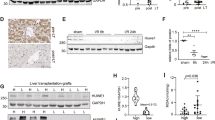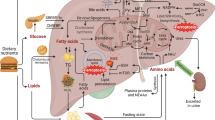Abstract
Recent studies in a murine model show that transferrin (Tf) interferes with Fas-mediated hepatocyte death and liver failure by decreasing pro-apoptotic and increasing anti-apoptotic signals. We show here in vitro in murine and human hepatocyte cell lines and in vivo in mice that Fas-induced apoptosis is modulated by exogenous Tf and iron. The results obtained with iron-free Tf (ApoTf), iron-saturated Tf (FeTf), and the iron chelator salicylaldehyde isonicotinoyl hydrazone (SIH) in its iron-free and iron-saturated (FeSIH) forms indicate that apoptosis-modulating effects of Tf are not mediated by iron alone. Both the Tf molecule and iron affect multiple aspects of cell death, and the route of iron delivery to the cell may be critical for the final outcome of cellular Fas signaling. Survival of hepatocytes ‘stressed’ by Fas signals can be manipulated by Tf and iron and may be a target for prophylactic and therapeutic interventions.
Similar content being viewed by others
References
Crichton RR. Proteins of iron storage and transport. (Review). Adv. Protein Chem. 1990; 40: 281–363.
de Jong G, van Dijk JP, van Eijk HG. The biology of transferrin. (Review). Clinica Chimica Acta 1990; 190: 1–46.
Ponka P, Beaumont C, Richardson DR. Function and regulation of transferrin and ferritin [Review]. Semi. Hematol. 1998; 35: 35–54.
Lesnikova M, Lesnikov V, Arrighi S, Kistler G, Pierpaoli W, Deeg HJ. Upregulation of interleukin-10 and inhibition of alloantigen responses by transferrin and transferrin-derived glycans. J. Hematoth. Stem Cell Res. 2000; 9: 381–392.
Lesnikov V, Lesnikova M, Deeg HJ. Pro-apoptotic and anti-apoptotic effects of transferrin and transferrin-derived glycans on hematopoietic cells and lymphocytes. Experim. Hematol. 2001; 29: 477–489.
Weinzimer SA, Gibson TB, Collett-Solberg PF, Khare A, Liu B, Cohen P. Transferrin is an insulin-like growth factor-binding protein-3 binding protein. J. Clin. Endocrinol. Metab. 2001; 86: 1806–1813.
Storch S, Kubler B, Honing S, et al. Transferrin binds insulin-like growth factors and affects binding properties of insulin-like growth factor binding protein-3. FEBS Letters 2001; 509: 395–398.
Fassl S, Leisser C, Huettenbrenner S, et al. Transferrin ensures survival of ovarian carcinoma cells when apoptosis is induced by TNFalpha, FasL, TRAIL, or Myc. Oncogene 2003; 22: 8343–8355.
Ogasawara J, Watanabe-Fukunaga R, Adachi M, et al. Lethal effect of the anti-Fas antibody in mice [published erratum appears in Nature 1993 Oct 7;365(6446):568]. Nature 1993; 364: 806–809.
Lesnikov VA, Lesnikova MP, Shulman HM, et al. Prevention of Fas-mediated hepatic failure by transferrin. Laborat. Invest. 2004; 84: 342–352.
Templeton DM, Liu Y. Genetic regulation of cell function in response to iron overload or chelation (Review). Biochim. Biophys. Acta 2003; 1619: 113–124.
van den Dobbelsteen DJ, Nobel CS, Schlegel J, Cotgreave IA, Orrenius S, Slater AF. Rapid and specific efflux of reduced glutathione during apoptosis induced by anti-Fas/APO-1 antibody. J. Biol. Chemis. 1996; 271: 15420–15427.
Domenicotti C, Marengo B, Nitti M, et al. A novel role of protein kinase C-delta in cell signaling triggered by glutathione depletion. Biochem. Pharmacol. 2003; 66: 1521–1526.
Pierpaoli W, Lesnikov VA, Lesnikova MP, Arrighi S, Bardotti A. Unresponsiveness to human leukocytes in immunosuppressed mice by combined donor-derived human transferrin and antigens. Trans. Immunol. 1996; 4: 301–308.
Hermes-Lima M, Ponka P, Schulman HM. The iron chelator pyridoxal isonicotinoyl hydrazone (PIH) and its analogues prevent damage to 2-deoxyribose mediated by ferric iron plus ascorbate. Biochim. Biophy. Acta 2000; 1523: 154–160.
Wu JC, Merlino G, Fausto N. Establishment and characterization of differentiated, nontransformed hepatocyte cell lines derived from mice transgenic for transforming growth factor alpha. Proc. Nat. Acad. Sci. USA 1994; 91: 674–678.
Arsura M, FitzGerald MJ, Fausto N, Sonenshein GE. Nuclear factor-kappaB/Rel blocks transforming growth factor beta1-induced apoptosis of murine hepatocyte cell lines. Cell Growth & Differentiation 1997; 8: 1049–1059.
Buss JL, Neuzil J, Gellert N, Weber C, Ponka P. Pyridoxal isonicotinoyl hydrazone analogs induce apoptosis in hematopoietic cells due to their iron-chelating properties. Biochem. Pharmacol. 2003; 65: 161–172.
Alcantara O, Javors M, Boldt DH. Induction of protein kinase C mRNA in cultured lymphoblastoid T cells by iron-transferrin but not by soluble iron. Blood 1991; 77: 1290–1297.
Vercammen D, Brouckaert G, Denecker G, et al. Dual signaling of the Fas receptor: Initiation of both apoptotic and necrotic cell death pathways. J. Experim. Med. 1998; 188: 919–930.
Wang X, Ryter SW, Dai C et al. Necrotic cell death in response to oxidant stress involves the activation of the apoptogenic caspase-8/bid pathway. J. Biol. Chem. 2003; 278: 29184–29191.
Quirk SM, Harman RM, Huber SC, Cowan RG. Responsiveness of mouse corpora luteal cells to Fas antigen (CD95)-mediated apoptosis. Biol. Reprod. 2000; 63: 49–56.
Ferris CD, Jaffrey SR, Sawa A et al. Haem oxygenase-1 prevents cell death by regulating cellular iron. Nature Cell Biol. 1999; 1: 152–157.
Kakhlon O, Cabantchik ZI. The labile iron pool: Characterization, measurement, and participation in cellular processes (Review). Free Radical Biology & Medicine 2002; 33: 1037–1046.
Susin SA, Lorenzo HK, Zamzami N et al. Molecular characterization of mitochondrial apoptosis-inducing factor. Nature 1999; 397: 441–446.
Kim S, Ponka P. Effects of interferon-gamma and lipopolysaccharide on macrophage iron metabolism are mediated by nitric oxide-induced degradation of iron regulatory protein 2. J. Biol. Chem. 2000; 275: 6220–6226.
Darnell G, Richardson DR. The potential of iron chelators of the pyridoxal isonicotinoyl hydrazone class as effective antiproliferative agents III: The effect of the ligands on molecular targets involved in proliferation. Blood 1999; 94: 781–792.
Dhungana S, Taboy CH, Zak O, Larvie M, Crumbliss AL, Aisen P. Redox properties of human transferrin bound to its receptor. Biochem. 2004; 43: 205–209.
Author information
Authors and Affiliations
Corresponding author
Rights and permissions
About this article
Cite this article
Lesnikov, V.A., Abbasi, N., Lesnikova, M.P. et al. Protection of human and murine hepatocytes against Fas-induced death by transferrin and iron. Apoptosis 11, 79–87 (2006). https://doi.org/10.1007/s10495-005-3086-2
Published:
Issue Date:
DOI: https://doi.org/10.1007/s10495-005-3086-2




